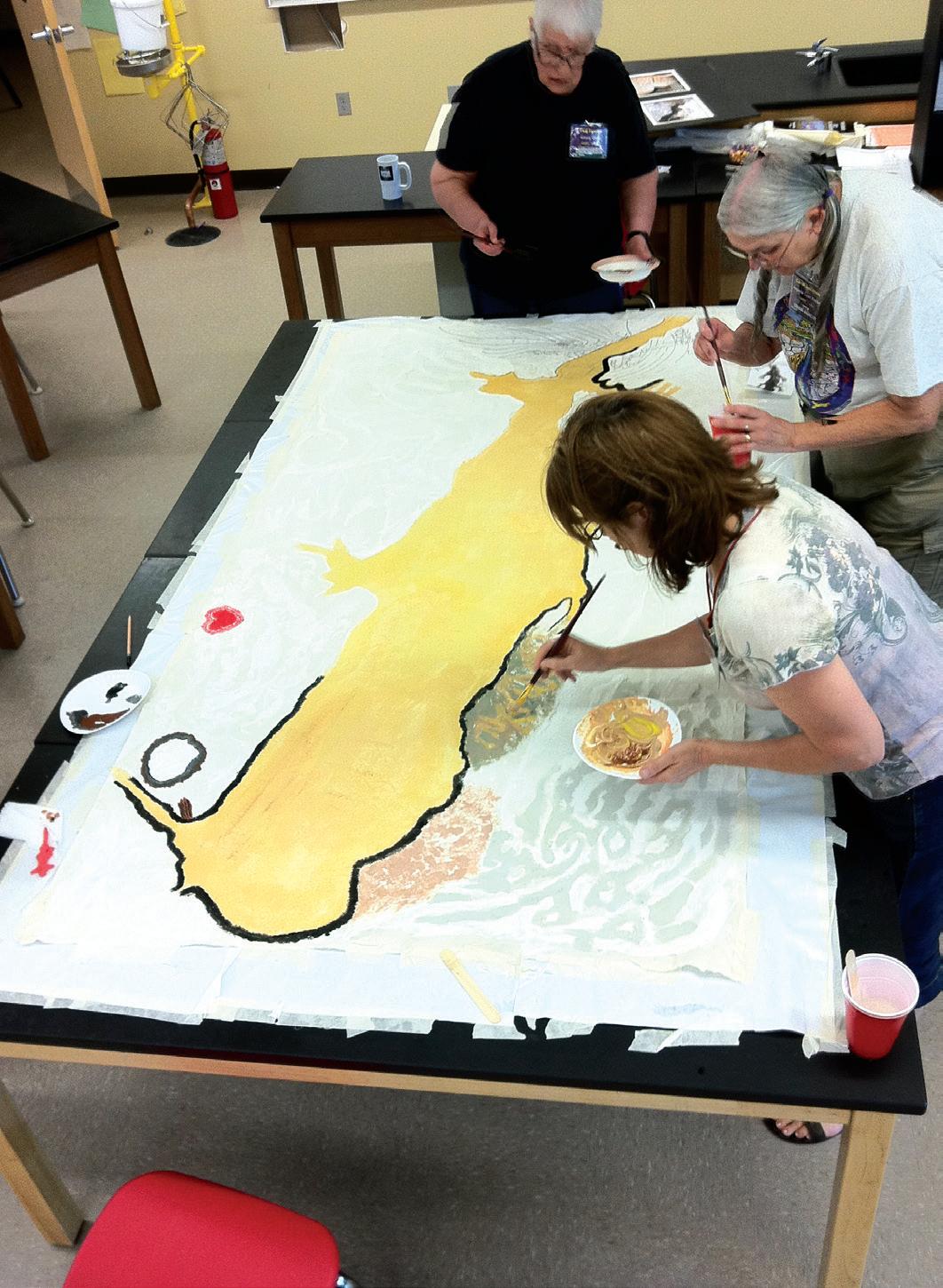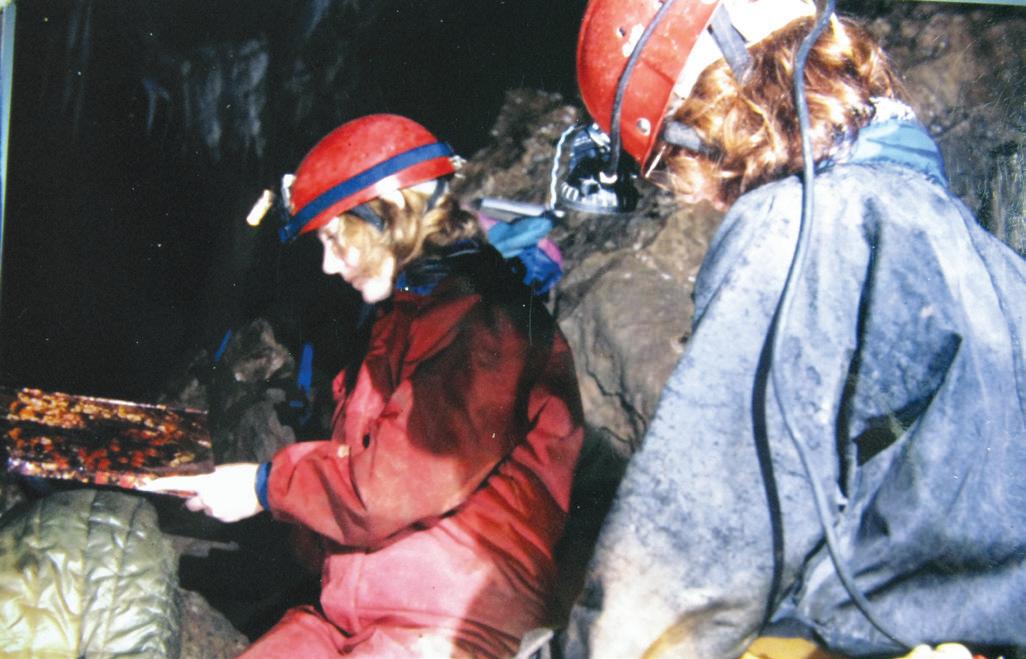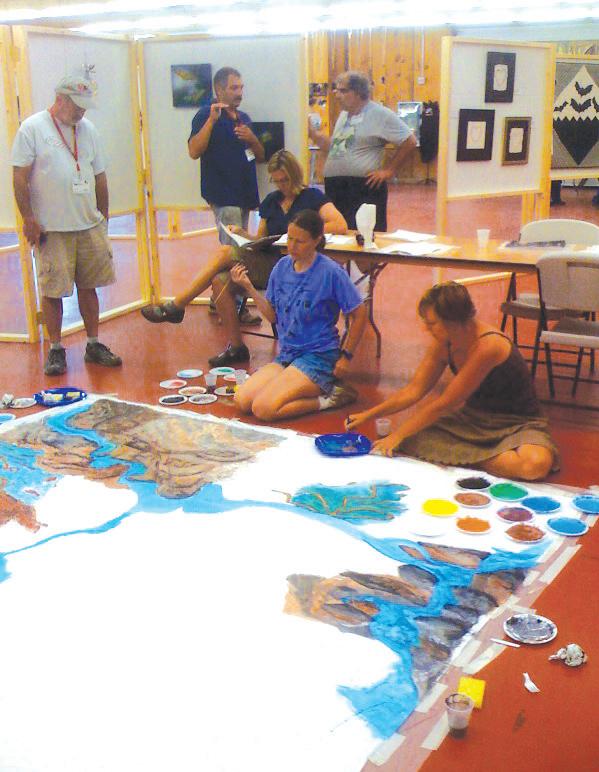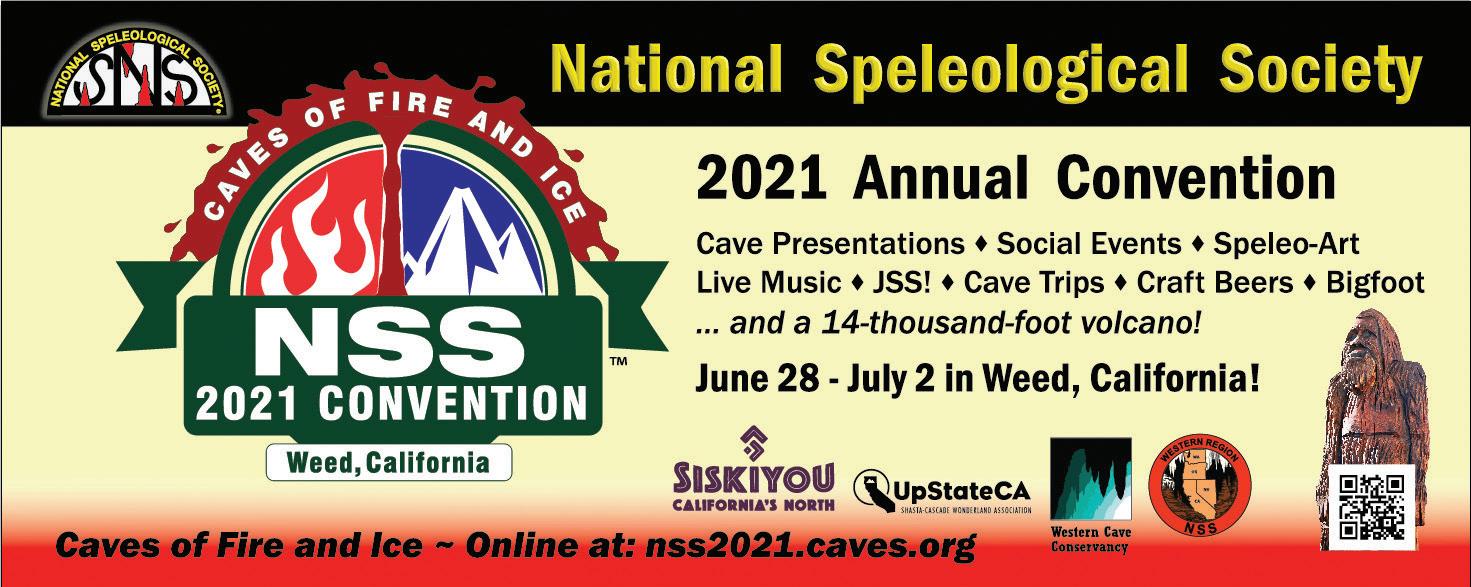
12 minute read
The History of SpeleoArt Carolina Shrewsbury
&Arts Letters Section
The History of SpeleoArt Carolina Shrewsbury NSS #46182RL (AL-FE) Fine Arts Chair
Advertisement
What has art got to do with Speleology?
This was the first question I was asked when I first presented my own artwork at the 1993 British Cave Research Association Conference in Bristol, GB.
I am an artist. That is my profession and the field I work in with people of all ages. I have also been an active caver for more than 40 years. Firstly, in college as a sport, which meant, go out, drink a lot, and then exhaust oneself on a 'hard trip' the next day. It has always been enormous fun and I have met with the most wonderful people in the process. Even married three of them!!
One day in 1985, I was on a photographic trip in Switzerland. An incident occurred that changed my whole view of the cave and the life I led within speleology.
Koebi, who was from the next village to where I lived at the time, had accompanied us on a photography trip with his brother. He wanted to take a photograph of a passage from the level of a small pool. A tight passage went off behind the pool, where the camera could be positioned. Koebi sent his very reluctant brother off into this small passage to take the photograph. Koebi walked up the main passage to pose. His brother, though, was bigger than Koebi and was having a real struggle to get into this small space. He did not want to do it.
Koebi started getting upset and became more insistent about getting the shot. Eventually, after scuffling with one another, the camera was set, and the brother was still reasonably dry but precariously balanced over the pool. Koebi was standing ready at the top of the passage when his brother opened the shutter on the camera. For some unknown reason, except to himself, he broke out into a run down the passage towards the pool, then took a huge leap into the middle. Like a tidal wave, the water swept over the camera and his brother. The scene was captured on our camera, but the photo was not in good condition and was eventually discarded. I painted the scene, just for fun. That was it. It was fun. NSS Convention SpeleoArt Collaborative in Colorado 2012.

I continued painting things like that for several years. Scenes from my exploits. Gifts to give to friends at Christmas, birthdays, etc. I never had enough money. I knew a picture of an event they could relate to always would go down well. One day in 1992, Mark Dougherty, the then editor of the BCRA publication, Caves and Caving, said he wanted to see some pictures I had done years before because he had found another artist, Bud Hogbin, who was the owner of some famous cave photos of the Berger. She had used the photographs as an inspiration for her own work. He decided he wanted to publish artwork in the magazine for the first time. The reaction was explosive.
There were reactions from positive to the very negative. My own thoughts to this were of
&Arts Letters Section
bewilderment. I had taken up caving at college as an art student and I had the view that everybody went caving because they felt about it like I did. It was beautiful, there was a lot to learn and I was curious. I feel so close to the earth and the basic elements of earth, water and air. I love to move through the cave. I love the grace with how one can approach an obstacle and overcome it with a few swift skilled movements. This is the art of caving. How can anyone miss that? So, we have the obvious natural beauties of the cave in the calcite deposits. That is the cave’s art and is often best captured by the photographer.
In 1993, I initiated ISSA, International Society of Speleological Art. A now growing group of dedicated speleological artists, not all cavers, but professional and very careful in their approach to the subject. The object was to have a platform for our mutual interest, have organised field trips for workshops dedicated to caves, and to plan exhibits of our work all over the UK.
By 1994, I wanted to explore the world and find exactly the extent of interest in speleological art. It is a huge job. In order to accomplish this, I started by organizing and coordinating an exhibition at the Swiss National Congress of Speleology 1995, in Breitenbach, a small town near Basel, in Switzerland. This was all achieved by phone call and mostly the old-fashioned postal system! Initially, I had expected the members of ISSA to participate. That was why I got them together in the first place. To provide a small showpiece to a speleological public that would be of an international representation.
One of the members had booked with me to go to Breitenbach for the meeting where I was to present the proposal to exhibit. The day before the flight, she backed out. ISSA had voted unanimously, at the eleventh hour, not to have anything to do with it. I received an extremely terse letter from the group as to what I could and could not do and say. I was given very strict conditions not even to mention the group’s existence and that I was not to ever mention again my actual part in forming the group! I was literally left alone, rather distraught, to turn up at our meeting with the Swiss Speleological Society in Switzerland to arrange the 'exhibition with no artists.'
What could I do? I asked them. I did not want to do it on my own. That would completely lose the point of it. There was no point displaying one artist with intention of introducing the subject as a valid interest within speleology with the object of becoming more than just pictures at an exhibition. As far as I could see, speleoart was something that could be introduced as a simple and attractive subject that would present speleology as a science that is also an art. Caves are beautiful
and speleology is clever.
With the help of my team in Switzerland and their friends. I wrote to book publishers and magazines. I eventually gathered work through a mix of cavers from all over Europe and Canada. We put up 17 paintings all around the main banqueting hall. A hastily arranged three-minute music and light show and ten-minute talk later, I received a standing ovation and an invitation to work with a team in SubLime, the 1997 Swiss UIS Congress Committee, to coordinate for a big international exhibition that was to become a main feature of the UIS Congress in 1997.
The object here was, now I knew that the artist/ speleologist existed I could reinvent the quest for recognition for speleoartists and their work.
Halfway through the organising of the event, SpeleoArt was born. We started with a fax machine and a borrowed email address. The email was not used that much then. The fax bill was horrendous, though it was invaluable with regards to the quick and efficient communication we needed in order to get the exposure SpeleoArt required at the Congress. It all paid off. With several new artists from around the globe, all speleologists, we had trips to local caves for sketching and sign language. We discussed what we each expected of SpeleoArt.
What is SpeleoArt?
It is not a group, club or society, for the simple fact that to become one of these would immediately politicise it, leaving it open to those may abuse or change the founding principles. We are now just a name that describes our interest. A word, that belongs to all who participate in the art of speleology.
SpeleoArt is about gathering speleologists from anywhere around the globe, whether virtually or in person, who are creative. We have a very valued team of supporters that understand the principles of SpeleoArt. We share the growing workload. Some of us lead classes or workshops on a variety of subjects, whether quilting, painting, sketching, writing, acting, dancing, playing music; you will see speleoart functioning anywhere cavers gather. In the early days of introducing speleoart, I had a team of dedicated people who helped set the stage for the interest. Linda Heslop in Canada, June MacLucas in
&Arts Letters Section
Australia, Ian Ellis Chandler in Spain, Carolina Martaud in France, Jerry Wallace in the USA, Franz Lindenmayr in Germany...and the others, as we grew into the organisations we eventually became in our own parts of the world. We started by providing participants with opportunities from creating a portfolio, to framing their work. Guidance with pricing had been a particular need and help to keep individual costs to an absolute minimum. We provided storage space, addresses to send work, and a workshop. I used to have a wonderful daily communication with the artists.
Now time has passed, and technology has freed our communications, we all use art forums like on Facebook to share our activities and encourage others to enjoy speleoart.
These were the things they and I wanted and have achieved. We are recognised as a valid and valued part of speleological interests. Twenty years ago, in 2000, we established an annual Salon exhibition at the National Speleological Society Convention now known as The Fine Arts Salon, which is affiliated with the NSS Arts and Letters Salon.
The History of the SpeleoArt Workshop.
The workshops like we have at the NSS Convention and OTR, started out as trips organised to caves around Great Britain. Generally, we would meet up in a pub or a hostel and stay for a whole weekend, going out to sketch and draw all day then meet up and decide what would be good to use for mediums we worked in back in our studios. Later, as I ventured more into Europe and the USA, I would take trips out to caves of a special nature, like an ice cave in Switzerland or a well decorated cave in France.
While still living in the UK, I started to broaden this idea. I became interested in what you could achieve in a ‘live’ situation by bringing cave art to the theatre. I found some inspiring music. I had the scenes in my head and painted hastily each one out then I presented them to a group of dancers I knew, who were willing to practice at a local church hall to create a scenewithout-a-frame entitled, 'Dances with Stalagmites.’ It took me two years from the first time I heard the music to eventually receive sponsorship for it to be successfully performed at a Speleological Arts Festival in Paris in 1998, in front of 1000 people.
On a long workshop session, over ‘97/’98, I worked with another speleoartist, Caroline Jacquin-Pentillon ISSA Group in GB Cave, Mendip, UK 1995.


Workshop fieldtrip, Switzerland 1997

&Arts Letters Section
from Paris, on a huge project based on topography which included several trips down Grotte du Vallorbe, a show cave on the Swiss/French border near Geneva. Our project involved sketching out landmarks along the route of the surveys we were working on. This meant travelling between three countries and a lot of faxed sketches between studios! We finished the project with a total of 28 huge canvases depicting the entire system in topographical Technicolor! It was on exhibition in the summer of 1998 along the entrance corridor for 6 weeks. It was during this project I researched painting mediums and produced a method of preserving canvases and found a humidity proof medium.
Since then I have worked on smaller workshops. I started educational workshops underground, initiating keen cavers to the arts of pencil and charcoal and how to light your underground. I started exhibiting in the USA regularly at the National Speleological Society Convention. Several American artists joined up with me in 1998, Lois Lyles, Marian McConnell, Jerry Wallace and Ken Storey. All of us dedicated with promoting caves in art and their artists. We negotiated with the NSS and agreed to set up a Salon, which worked for a while in collaboration with SpeleoArt, until 2017.
The Fine Arts Salon, the official body for the interests in speleological arts within the NSS, exhibits once a year. Speleoartists can enter their works for a small fee and commission on sales. Professionals in the world of arts and the sciences judge it and awards are given for outstanding work.
In 2020, we are still evolving and growing our speleoart body. The Arts and Letters Section, the literary side of speleoarts, has become a Salon. It has a biannual magazine, Illuminations, dedicated to all spelean arts. This year Illuminations will present its own special issue to celebrate the 20th anniversary of the founding of the NSS Fine Arts Salon with its 32nd issue. Next year, the Arts and Letters Salon will officially be presented as a complementary exhibition and showcase for the Literary SpeleanArts. Its own workshop on Fridays at Convention, led by Michael Ray Taylor and Jo Schaper, has become a staple for writers of all things Spelean.
It is important we remember our roots. Once we were very small, funding was minimal and hard to find in a world dedicated to science and exploration. We did it though, we made it! We are here to stay, and to celebrate the many influences and creativity of speleology with those who bring it to us all to enjoy. Collaborative, Vermont 2010.


The first Collaborative, La Chaux-De-Fonds, CH 1997.

&Arts Letters Section
SpeleoArt exists to promote the understanding of science through art. SpeleoArt exists to generate interest in conserving karst and cave areas. SpeleoArt exists to provide opportunities to all people interested in speleological art. To encourage creativity and to promote this art in all its forms.
SpeleoArt exhibitions:
• National Speleological Congress, Breitenbach, Switzerland. October 1995. • International Speleological Congress, La Chaud-de-Fonds, Switzerland. August 1997. • National Speleological Society Convention, Sewanee, Tennessee, U.S.A. August 1998. • 12e Festival de Spele ologie,en Ile-de France, Paris, France. November 1998. • Australian Speleological Federation, Queensland. January 1999. • National Speleological Society Convention, Twin Falls, Idaho, USA. July 1999. • 13e Festival de Speleologie,en Ile-de France, Paris, France. November 1999. • National Speleological Society Convention, Elkins, West Virginia. USA. June 2000. • Australian Speleological Federation, Bathurst, NSW. January 2001. • National Speleological Society Convention, The Fine Arts Salon, Rockcastle, Kentucky, USA. July 2001. • National Speleological Society Convention, The Fine Arts Salon, Camden, Maine, USA. June 2002 . . . .
. . . . and still at National Speleological Society Convention!
Next year: National Speleological Society Convention, The Fine Arts Salon, Weed, California, USA





